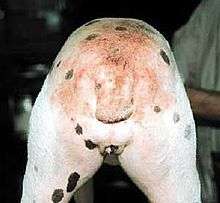Flea allergy dermatitis
Flea allergy dermatitis is an eczematous itchy skin disease of dogs and cats.

For both of these domestic species, flea allergy dermatitis is the most common cause of skin disease. Affected animals develop allergic reactions to chemicals in flea saliva. Symptoms of this reaction include erythema (redness), papules (bumps), pustules (pus-filled bumps), crusts (scabs) also if severe, hair loss will occur in affected area.[1] Dogs with flea allergy dermatitis often show hair loss and eczematous skin rash on the lower back, upper tail, neck and down the back of the legs. Cats with flea allergy dermatitis may develop a variety of skin problems, including feline eosinophilic granuloma, miliary dermatitis or self-inflicted alopecia from excessive grooming.
The diagnosis of flea allergy dermatitis is complicated by the grooming habits of pets. Cats in particular are very efficient at grooming out fleas, often removing any evidence of infestation. Fleas begin biting within 5 minutes of finding a host and there are no flea treatments that kill fleas before biting occurs.[2] Pets that develop FAD have an allergic response to flea saliva injected during flea feeding. The itch associated with just one flea bite persists long after that flea is gone and leads to significant self-trauma.
The approach with a flea allergic pet is to reduce flea numbers in the environment and on the affected pet. Environmental flea control includes using flea foggers or bombs, vacuuming and treating pet bedding by washing on a hot cycle (over 60 degrees Celsius) in the washing machine. The current on-pet treatment recommended by veterinary dermatologists is Spinosad (Comfortis) monthly and Nitenpyram (Capstar or generics) every 48 hours until improvement.
In some cases secondary bacterial or yeast infections will also need treatment before the itching subsides. Many pets who have FAD may also have other allergies, such as allergies to food, contact allergies and atopic dermatitis.
See also
References
- ↑ FreeFree Allergy Dermatitis. http://www.dr-dan.com/flea.htm
- ↑ Dryden M.W. and Rust M.K. (1994) The cat flea: biology, ecology and control, Veterinary Parasitology, 52: 1-19.